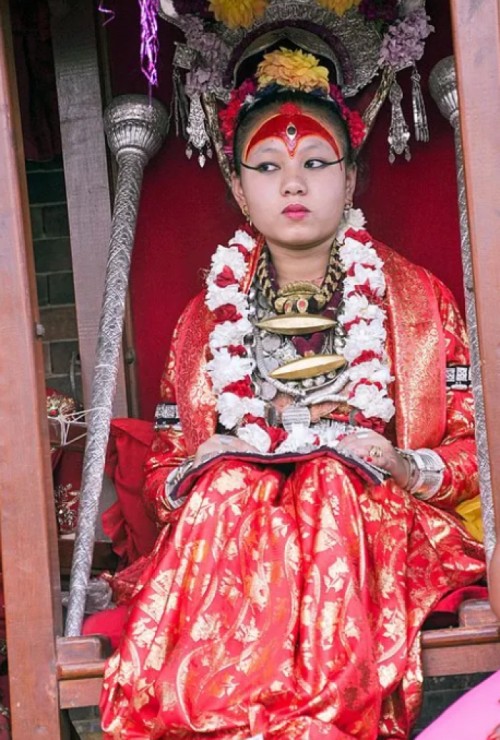
The Living Goddess: Nepal’s Sacred Kumari
-
- 0 Share
- 678 Views
Kumari, the living goddess, represents Taleju Bhawani and is said to be the living incarnation of the goddess herself. Legend states that the ancient kings of Nepal were devotees of goddess Taleju. Therefore, she would often visit the palace to play games of cards with the kings. Due to a conflict with King Jayaprakash Malla, it is said that the goddess got upset and disappeared. After countless prayers asking for forgiveness by the king, she appeared in his dreams and asked the king to choose a young Kumari for her to possess so that the people could continue to worship her. A Kumari candidate is selected from a Buddhist family of Shakya clan. Once selected, she is deeply revered by both Hindus and Buddhists. In the past, even the Shah Kings followed the tradition of receiving tika and blessings from her. She is taken out of her temple to participate in several festivals. Once a Kumari attains puberty, she loses the divine status and the selection for another Kumari begins. There are different Kumaris in Patan, Bhaktapur, Bungmati, Thimi and other Newar towns. The selection process of a Kumari resembles that of Tibetan Lamas. Dating back to the 17th century, the practice was institutionalized by a Malla King.
The famous Kumari Temple is situated right across the historical Gaddi Baithak Hall at Basantapur in Kathmandu. Kumari Ghar, the house of Living Goddess Kumari, is located on the southern side of the Kathmandu Durbar Square premises. Built by King Jaya Prakash Malla in 1757, Kumari Ghar is an example of Nepal’s magnificent architecture with its intricate wood carvings of gods and various symbols. Visit the Kumari Ghar at Basantapur, where the goddess resides and get a glimpse of the living deity. If you are visiting around late August or early September, then be sure to be a part of the biggest and most vibrant festival in Kathmandu called Indra Jatra, where the Kumari, is paraded across the city, in her golden palanquin. The Kumari, or Living Goddess of Nepal, is a unique cultural tradition deeply rooted in the Kathmandu Valley. This tradition involves selecting young girls from specific Newari families to be worshipped as the embodiment of the goddess Taleju Bhawani and Durga. These girls are believed to possess divine powers and are revered by both Hindus and Buddhists. Here are some key aspects of the Kumari story:
Selection Process: Young girls are chosen based on specific criteria, including physical and mental purity, and must pass rigorous tests to be deemed suitable for the role. Once selected, they are believed to be inhabited by the goddess and are treated with utmost reverence.
Daily Life: The Kumari lives in a palace and is worshipped daily by devotees. She is not allowed to attend school but studies at home and receives worship every day. Her presence is believed to bring good fortune to those who see her.
End of Reign: The Kumari's reign ends when she reaches puberty, typically around age 11, or if she experiences any accidental loss of blood. After this, she returns to her family and a new Kumari is chosen.
Historical Significance: The tradition dates back centuries and was particularly significant during the reign of the Malla kings, who believed in the divine power of the Kumari. Even after the abolition of the monarchy, the Kumari continues to be an important cultural figure in Nepal.
Contemporary Issues: There are ongoing debates about the Kumari tradition, with some advocating for reforms to ensure the girls' education and human rights are protected. Former Kumaris like Chanira Bajracharya have used their experiences to advocate for better education and support for girls in similar roles.
Impact of Natural Disasters: During natural disasters, such as the 2015 earthquake, the Kumari's safety and well-being have been a concern. The earthquake forced the Kumari to leave her quarters for the first time in decades, highlighting the challenges faced by the tradition in modern times.
Please
